Boracay, located in the Philippines, is a tropical paradise known for its pristine beaches and azure waters. But have you ever wondered about the intriguing history hidden beneath its picturesque surface? How did this paradise come to be? What stories and legends shaped the formation of Boracay? In this section, we will peel back the layers of time and explore the rich history and folklore surrounding Boracay Island.
From legends of forbidden love to the island’s evolution into a sought-after tourist destination, Boracay’s history is a tapestry woven with captivating tales and remarkable events. Join us as we venture into the depths of Boracay’s past, unearthing fascinating historical facts, exploring its ancient sites, and uncovering the stories that have shaped this tropical gem.
Key Takeaways:
- Dive into the fascinating history and folklore surrounding Boracay Island.
- Discover the legends and stories that shaped the formation of Boracay.
- Explore how Boracay has evolved into a world-class tourist destination over the years.
- Uncover hidden historical facts and ancient sites on the island.
- Gain a deeper appreciation for the rich cultural heritage of Boracay.
Legend of Boracay’s Origin
According to local folklore, the mesmerizing island of Boracay has a captivating origin story steeped in legend and romance. The tale revolves around two star-crossed lovers, Anini, a fairy, and Bora, a mortal man, whose forbidden love defied all odds.
In their desperate attempt to be together against all odds, Anini and Bora faced the wrath of the heavens. As punishment for their defiance, they were transformed into separate islands. Boracay, which took on Bora’s name, emerged as an enchanting paradise, while Panay became a symbol of Anini’s ethereal beauty.
“The islands of Boracay and Panay were once connected, but a fierce storm tore them apart. Boracay became a haven of pristine beaches, crystal-clear waters, and captivating sunsets, while Panay retained the magic of Anini’s spirit,”
This beguiling legend has been passed down through generations, etched into the hearts and minds of the locals. It serves as a reminder of the enduring power of love and the transformational beauty of Boracay.
Geographical Overview of Boracay
Boracay, a small island situated in the Western Visayas region of the Philippines, offers a delightful blend of stunning geography, picturesque beaches, and distinct divisions. With a length of over 4 kilometers, Boracay is a tropical paradise that beckons beach enthusiasts and water sports lovers from around the world.
The island is divided into three main areas, namely Station 1, Station 2, and Station 3. Each station showcases a unique charm and caters to different preferences, making Boracay a versatile destination for all types of travelers. Whether you seek peaceful relaxation, vibrant nightlife, or thrilling water activities, Boracay has something to offer.
One of the greatest attractions of Boracay is its world-famous beaches. The powdery white sand and crystal-clear turquoise waters create an idyllic setting for sunbathing, swimming, and various water sports. From the serene shores of Puka Beach to the vibrant energy of White Beach in Station 2 and the laid-back ambiance of Bulabog Beach in Station 3, Boracay’s beaches cater to all preferences and provide unforgettable experiences.
With its geographical diversity and stunning beaches, Boracay is a haven for tourists seeking a tropical paradise. Whether you choose to unwind on the shores, explore the island’s natural wonders, or indulge in thrilling water activities, Boracay offers a delightful experience for every visitor.
So pack your bags and prepare to immerse yourself in the beauty of Boracay’s geography and beaches. Your dream tropical getaway awaits!
Boracay Divisions and Beaches
| Division | Main Beaches |
|---|---|
| Station 1 | White Beach, Diniwid Beach |
| Station 2 | White Beach, Bulabog Beach |
| Station 3 | White Beach, Bulabog Beach |
Getting to Boracay
If you’re planning a trip to Boracay, it’s essential to know how to get there and make your travel experience smooth and hassle-free. There are two main airports you can fly into to reach this picturesque island paradise: Godofredo P. Ramos Airport (Caticlan Airport) and Kalibo International Airport. Let’s explore these options and some helpful travel tips to make your journey to Boracay unforgettable.
Flying to Godofredo P. Ramos Airport (Caticlan Airport)
Godofredo P. Ramos Airport, also known as Caticlan Airport, is the most convenient airport to fly into for a direct transfer to Boracay. Several airlines offer flights from Manila and Cebu to Caticlan Airport, making it easily accessible from major cities in the Philippines. Once you arrive at Caticlan Airport, a short tricycle ride will take you to Caticlan Jetty Port, where you can catch a boat to Boracay Island. It’s a quick and efficient way to begin your beach getaway.
Flying to Kalibo International Airport
Kalibo International Airport is another option to consider when planning your trip to Boracay. While it requires a longer land and sea transfer compared to Caticlan Airport, flights to Kalibo International Airport may sometimes be more affordable, especially during peak travel seasons. From Kalibo Airport, you can take a bus or van to Caticlan Jetty Port, where you can board a boat to Boracay Island. Although the journey takes a bit longer, it provides an opportunity to explore the scenic landscapes of Aklan province.
Travel Tips for Getting to Boracay
When traveling to Boracay, it’s essential to keep a few tips in mind to ensure a smooth and enjoyable journey:
- Book your flights and accommodations in advance, especially during peak travel seasons, as Boracay is a popular destination.
- Check the baggage restrictions of your airline to avoid any last-minute surprises at the airport.
- Don’t forget to bring your travel essentials, such as sunscreen, a hat, sunglasses, and a beach towel, to protect yourself from the sun’s rays.
- Consider bringing cash with you, as some establishments may not accept credit cards. There are also ATMs available on the island.
- Be aware that a sustainable tourism fee is collected upon arrival at Caticlan Jetty Port. This fee goes towards preserving the natural beauty of Boracay.
By following these travel tips and choosing the most convenient airport for your journey, you’ll be on your way to experiencing the breathtaking beauty of Boracay. Start planning your trip and get ready to create unforgettable memories on this tropical paradise.
Exploring Boracay’s Tourist Destinations
Boracay, with its breathtaking beauty and pristine beaches, is a paradise for travelers seeking memorable experiences. This section highlights some of the must-visit tourist spots, attractions, and stunning beaches that make Boracay a top destination.
Puka Shell Beach
Located on the northern part of the island, Puka Shell Beach offers a tranquil retreat surrounded by natural beauty. This scenic beach is famous for its powdery white sand and abundant puka shells, making it a favorite spot for shell collectors and beachcombers.
Ariel’s Point
For adrenaline junkies looking for an exhilarating experience, Ariel’s Point is the ultimate destination. Situated just a short boat ride from Boracay, this cliff diving spot features platforms at various heights, attracting thrill-seekers from around the world.
Mount Luho
If you’re craving breathtaking panoramic views of Boracay, a visit to Mount Luho is a must. Make your way to the island’s highest peak and be rewarded with a stunning vista that stretches as far as the eye can see. Don’t forget your camera!
Willy’s Rock
One of Boracay’s iconic landmarks, Willy’s Rock stands majestically in the crystal-clear waters. This picturesque attraction features a small chapel built on a lava formation, creating a unique blend of nature and spirituality.
Other Must-Visit Destinations
Aside from the above, Boracay offers a plethora of other enchanting destinations. Diniwid Beach, with its peaceful ambiance and scenic views, is perfect for a relaxing getaway. Discover the beauty beneath the waves at Crocodile Island, a popular snorkeling and diving spot. Magic Island is another hotspot for thrill-seekers, with its towering diving platforms. And if you’re up for an adventure, explore the fascinating Boracay Bat Cave, home to a variety of bats and awe-inspiring rock formations.
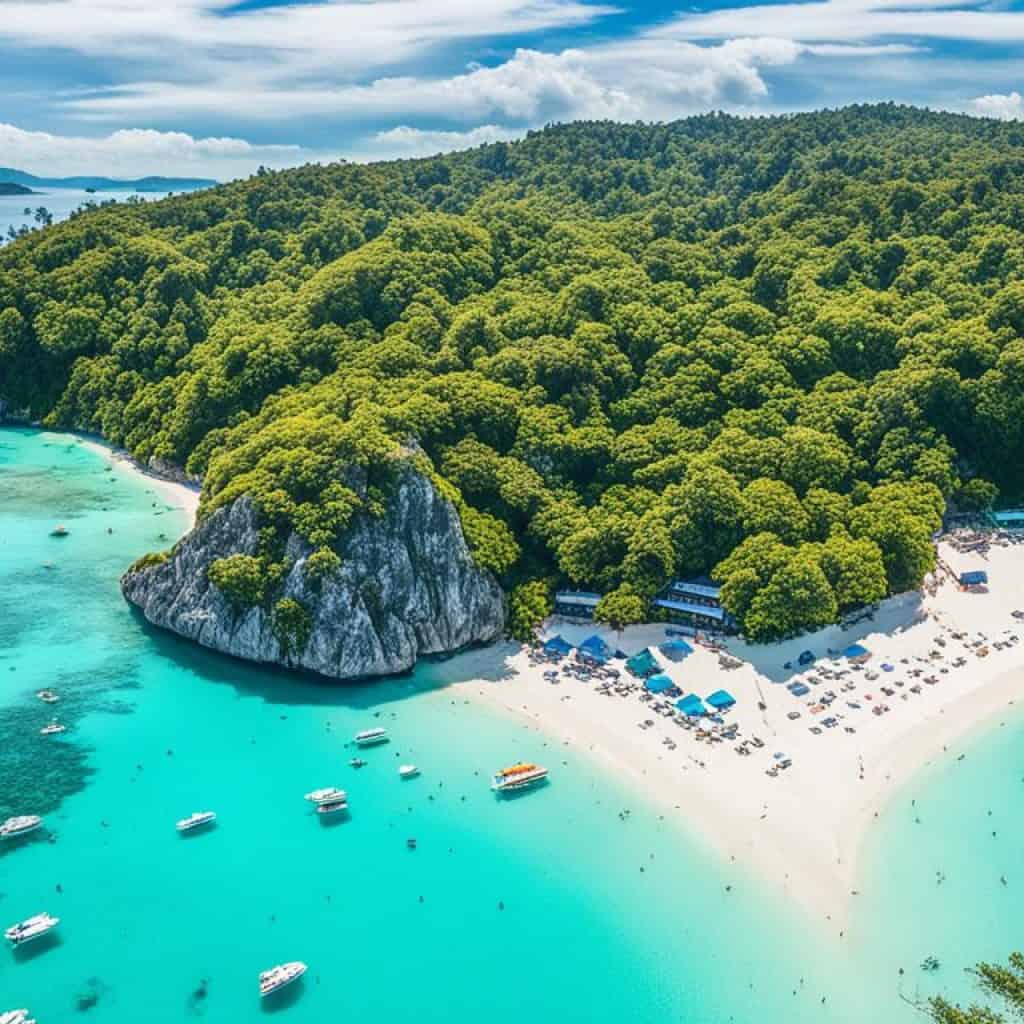
| Destination | Description |
|---|---|
| Puka Shell Beach | A tranquil beach known for its white sand and abundance of puka shells. |
| Ariel’s Point | A cliff diving spot that offers an exhilarating experience for thrill-seekers. |
| Mount Luho | The highest peak in Boracay with panoramic views of the island. |
| Willy’s Rock | An iconic landmark featuring a small chapel on a lava formation. |
| Diniwid Beach | A peaceful beach with scenic views, perfect for relaxation. |
| Crocodile Island | A popular destination for snorkeling and diving enthusiasts. |
| Magic Island | A hotspot for thrill-seekers, featuring towering diving platforms. |
| Boracay Bat Cave | A fascinating cave home to bats and impressive rock formations. |
Boracay’s Rich Cultural Heritage
Boracay is not just a tropical paradise; it also boasts a vibrant cultural heritage that visitors can explore and embrace. Engaging with the friendly locals allows you to experience the warmth of Filipino hospitality and immerse yourself in the island’s traditions.
Boracay culture is a beautiful blend of indigenous influences and modern developments, creating a unique tapestry of traditions and customs. One of the highlights of Boracay’s cultural calendar is the Ati-Atihan sa Boracay festival, a local version of the famous Ati-Atihan festival.
The Ati-Atihan sa Boracay festival is a colorful celebration that showcases the island’s indigenous roots. It features lively street processions where participants don traditional Visayan attire and paint their faces with vibrant colors. The rhythmic beat of drums and the chants of “Hala Bira!” fill the air as locals and tourists come together to join the revelry.
During the festival, you’ll have the opportunity to witness mesmerizing dances and performances, as well as taste traditional Filipino cuisine. The festival provides a deeper understanding of the island’s history and cultural significance.
In addition to festivals, exploring local Boracay traditions is a fantastic way to immerse yourself in the island’s rich cultural tapestry. You can visit artisans and craftsmen who showcase their skills in traditional weaving techniques, producing intricate textiles and handicrafts.
Local artists and talented individuals also contribute to Boracay’s cultural scene by creating beautiful artworks that reflect the island’s natural beauty and cultural heritage. Handmade souvenirs can serve as meaningful reminders of your trip to Boracay.
To fully appreciate the Boracay culture, take the time to engage with the locals, join in the festivities, and explore the island’s artistic and traditional expressions. By doing so, you will gain a deeper appreciation for the people, history, and traditions that make Boracay a truly remarkable destination.
The Ati-Atihan Festival: A Celebration of Indigenous Roots
The Ati-Atihan festival is one of the most iconic festivals in the Philippines, paying homage to the indigenous Ati people. Known for their joyful spirit and vibrant culture, the Ati people have a significant presence on Boracay, showcasing their traditions and cultural heritage through the Ati-Atihan sa Boracay festival.
This lively celebration is held every January in honor of Santo Niño, the Child Jesus. It is a time for locals and visitors alike to come together, don colorful attire, and immerse themselves in the rhythmic dances and energetic music that fill the streets of Boracay.
The Ati-Atihan festival boasts a rich history and has evolved over the years to become one of the most anticipated events on the island. The festivities include street parades, tribal competitions, cultural performances, and religious ceremonies.
As you wander through the vibrant crowds, you’ll witness groups of participants known as “tribes” showcasing their elaborate costumes and body paintings, which are a tribute to the Ati people’s ancestral traditions. The festival creates a joyful atmosphere, with laughter, music, and traditional chants permeating the air.
By joining in the festivities, you not only get to witness the cultural vibrancy of Boracay but also contribute to the preservation and promotion of the island’s indigenous roots. It’s an experience that will leave you with cherished memories and a deeper appreciation for Boracay’s rich cultural tapestry.
Boracay’s Hidden Historical Facts
Boracay, known for its stunning beaches and vibrant culture, holds a fascinating historical legacy that remains largely unknown to many. Beyond its picturesque landscapes and crystal-clear waters, the island conceals a rich history that is worth exploring. Let’s unravel the hidden historical facts that shaped Boracay into the paradise it is today.
The Ati Natives and Early History
Centuries ago, Boracay was home to the indigenous Ati natives, who inhabited the island long before the arrival of Spanish colonizers. Passed down through generations, their stories and customs provide glimpses into Boracay’s past. The Ati people held the island dear, viewing it as their private abode and cherishing its natural wonders.
During the early years of Spanish colonization, the island’s rich resources caught the attention of the Tirol and Gonzales families. Lamberto H. Tirol and Sofia Ner Gonzales played significant roles in the exploration, cultivation, and development of Boracay. Their efforts paved the way for progress and shaped the island’s future.
Commercialization and Controversies
As time passed, certain parts of Boracay were sold to other families, leading to the commercialization of the island. This transformation brought modern amenities, infrastructure, and an influx of tourists. However, it also sparked controversies, with debates surrounding land ownership, sustainability, and the preservation of Boracay’s natural beauty.
“Boracay’s history is a tapestry of intertwined narratives, reflecting the struggles, triumphs, and challenges faced by its people throughout the years.” – Local Historian
Historical Landmarks and Figures
Exploring Boracay allows visitors to encounter historical landmarks that bear witness to its past. Willy’s Rock, an iconic formation adorned with a small chapel, stands as a testament to the island’s cultural and religious heritage. These landmarks serve as reminders of the people and events that have shaped Boracay’s identity over time.
Additionally, Boracay is cherished for the contributions of Lamberto H. Tirol and Sofia Ner Gonzales, who played key roles in transforming the island into a renowned tourist destination. Their legacy echoes through the development and progression of Boracay, leaving an indelible mark on its history.
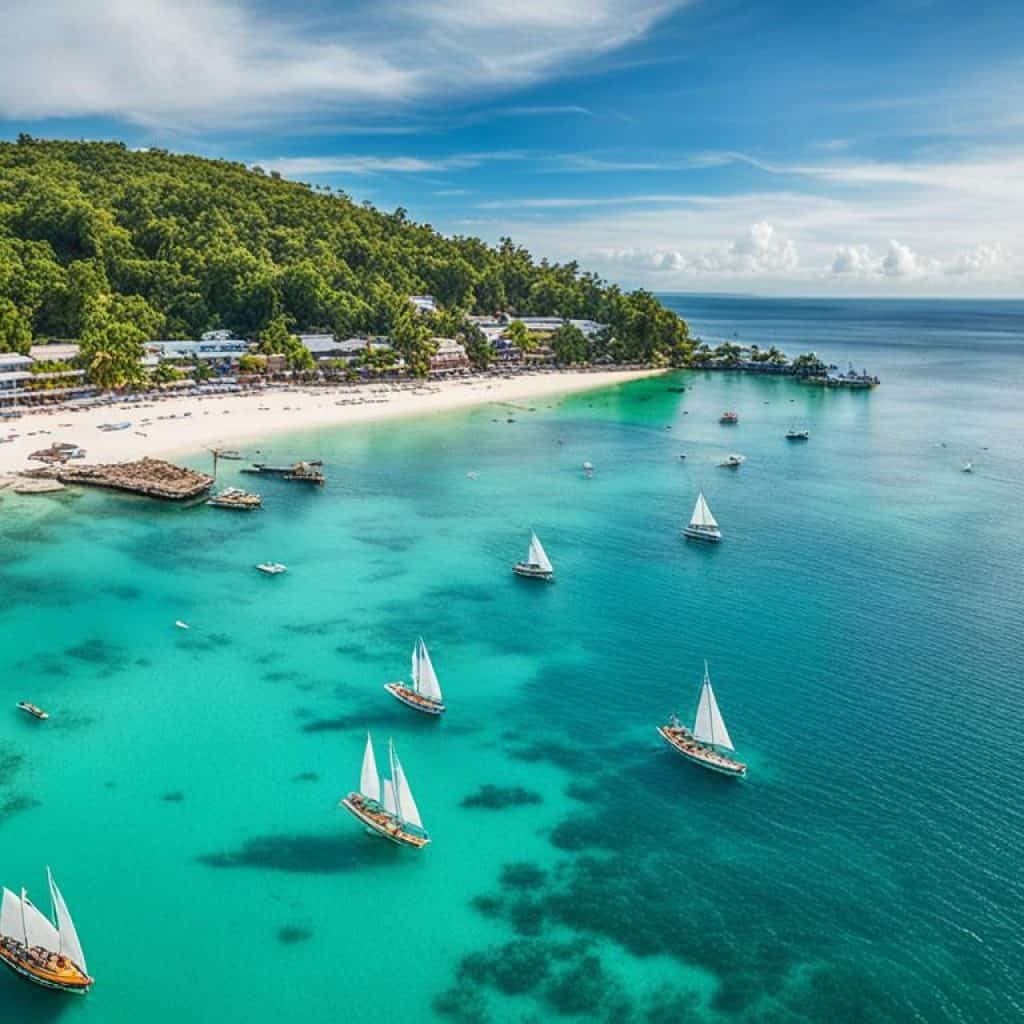
The Legacy Continues
From its early roots as an indigenous haven to its evolution into a global tourist hotspot, Boracay’s hidden historical facts add depth and character to its breathtaking landscapes. Exploring the island’s historical background enriches the overall experience, further immersing visitors in the cultural tapestry woven over centuries.
Uncover the untold stories, walk in the footsteps of the Ati natives, and appreciate the historical landmarks that stand as testaments to Boracay’s vibrant past. By embracing its history, visitors can forge a deeper connection with the island and truly appreciate the paradise that is Boracay.
Boracay Travel Tips
When planning a trip to Boracay, it’s important to consider some travel tips. Whether you’re a seasoned traveler or visiting for the first time, these tips will help you make the most of your vacation.
Best Time to Visit Boracay
The best time to visit Boracay is during the dry season, which runs from November to April. During this period, you can expect sunny weather with minimal chances of rainfall, perfect for enjoying outdoor activities and lounging on the beach.
Booking Accommodations in Advance
Boracay is a popular tourist destination, so it’s advisable to book your accommodations in advance to secure your preferred hotel or resort. By securing your lodging early, you can avoid any last-minute hassles and ensure a seamless and enjoyable stay on the island.
Packing Beach Essentials
When packing for your Boracay trip, don’t forget to include a few beach essentials. The sun can be intense, so make sure to pack sunscreen with a high SPF to protect your skin. A hat and sunglasses will provide additional protection from the sun’s rays. Don’t forget to bring a beach towel for lounging by the shore and drying off after a swim.
Respecting the Environment
Boracay’s natural beauty is one of its most cherished assets. It’s important to respect the environment and do your part in keeping the island clean and sustainable. Avoid littering, dispose of waste properly, and support eco-friendly initiatives during your stay. By being mindful of your actions, you can help preserve Boracay’s pristine beauty for future generations.
Exploring Local Delicacies
No trip to Boracay is complete without indulging in the local delicacies. From fresh seafood to traditional Filipino dishes, the island offers a wide array of flavors to delight your palate. Be sure to try popular dishes such as kinilaw (ceviche), adobo (marinated meat), and halo-halo (a refreshing dessert). Exploring the local food scene will enhance your overall Boracay experience.
By following these Boracay travel tips, you can ensure a memorable and enjoyable vacation on this tropical paradise. From choosing the best time to visit and booking accommodations in advance to packing your beach essentials and immersing yourself in the local culture, these tips will help you make the most of your Boracay getaway.
| Travel Tips | Details |
|---|---|
| Best Time to Visit Boracay | November to April (Dry Season) |
| Booking Accommodations | Secure lodging in advance |
| Beach Essentials | Sunscreen, hat, sunglasses, beach towel |
| Respecting the Environment | Avoid littering, dispose of waste properly |
| Exploring Local Delicacies | Try traditional Filipino dishes |
Conclusion
As we conclude this exploration of Boracay, it’s clear that this tropical paradise is more than just a beautiful beach destination. Its rich history, vibrant culture, and hidden historical facts make it a truly fascinating place to discover. From the legendary origin of the island to its evolution into a world-class tourist destination, Boracay offers a unique blend of natural beauty and cultural heritage.
By immersing yourself in the tourist destinations, engaging with the friendly locals, and experiencing the island’s traditions, you can truly appreciate the depth and allure of Boracay. Whether you’re basking in the powdery white sand beaches, cliff diving at Ariel’s Point, or exploring the historical landmarks, there’s something for everyone to enjoy.
In conclusion, Boracay is an enchanting destination that captivates the senses and leaves a lasting impression. Its breathtaking landscapes, warm hospitality, and intriguing history make it an ideal getaway for travelers seeking both relaxation and discovery. So pack your beach essentials, embrace the cultural heritage, and embark on an unforgettable journey to Boracay!
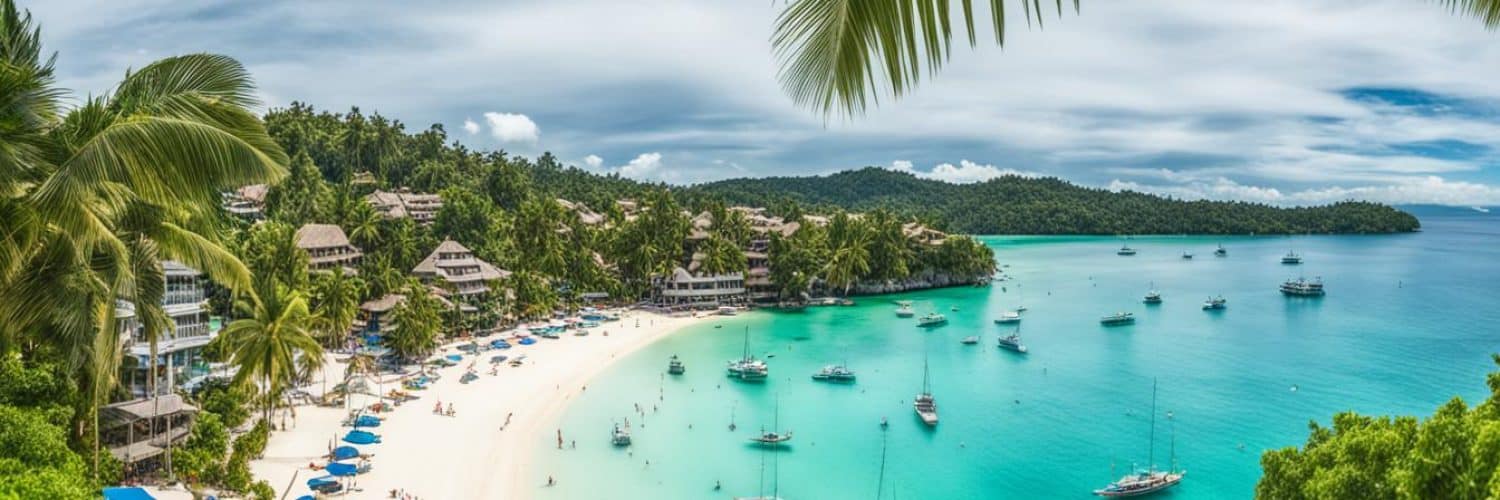
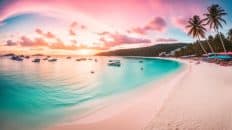
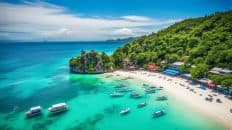
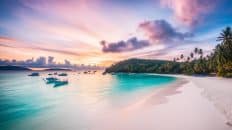














Add comment